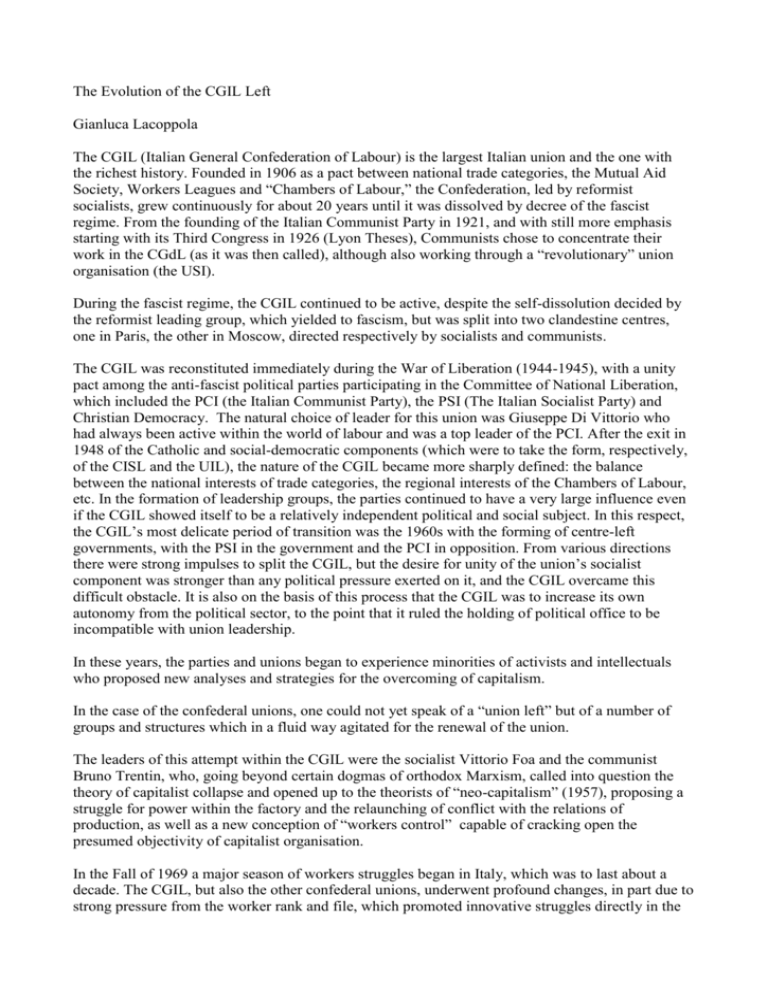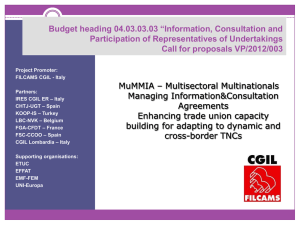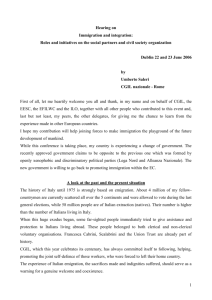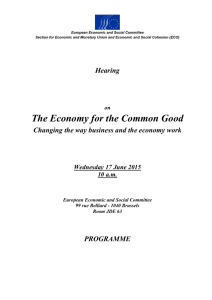The Evolution of the CGIL Left - s
advertisement

The Evolution of the CGIL Left Gianluca Lacoppola The CGIL (Italian General Confederation of Labour) is the largest Italian union and the one with the richest history. Founded in 1906 as a pact between national trade categories, the Mutual Aid Society, Workers Leagues and “Chambers of Labour,” the Confederation, led by reformist socialists, grew continuously for about 20 years until it was dissolved by decree of the fascist regime. From the founding of the Italian Communist Party in 1921, and with still more emphasis starting with its Third Congress in 1926 (Lyon Theses), Communists chose to concentrate their work in the CGdL (as it was then called), although also working through a “revolutionary” union organisation (the USI). During the fascist regime, the CGIL continued to be active, despite the self-dissolution decided by the reformist leading group, which yielded to fascism, but was split into two clandestine centres, one in Paris, the other in Moscow, directed respectively by socialists and communists. The CGIL was reconstituted immediately during the War of Liberation (1944-1945), with a unity pact among the anti-fascist political parties participating in the Committee of National Liberation, which included the PCI (the Italian Communist Party), the PSI (The Italian Socialist Party) and Christian Democracy. The natural choice of leader for this union was Giuseppe Di Vittorio who had always been active within the world of labour and was a top leader of the PCI. After the exit in 1948 of the Catholic and social-democratic components (which were to take the form, respectively, of the CISL and the UIL), the nature of the CGIL became more sharply defined: the balance between the national interests of trade categories, the regional interests of the Chambers of Labour, etc. In the formation of leadership groups, the parties continued to have a very large influence even if the CGIL showed itself to be a relatively independent political and social subject. In this respect, the CGIL’s most delicate period of transition was the 1960s with the forming of centre-left governments, with the PSI in the government and the PCI in opposition. From various directions there were strong impulses to split the CGIL, but the desire for unity of the union’s socialist component was stronger than any political pressure exerted on it, and the CGIL overcame this difficult obstacle. It is also on the basis of this process that the CGIL was to increase its own autonomy from the political sector, to the point that it ruled the holding of political office to be incompatible with union leadership. In these years, the parties and unions began to experience minorities of activists and intellectuals who proposed new analyses and strategies for the overcoming of capitalism. In the case of the confederal unions, one could not yet speak of a “union left” but of a number of groups and structures which in a fluid way agitated for the renewal of the union. The leaders of this attempt within the CGIL were the socialist Vittorio Foa and the communist Bruno Trentin, who, going beyond certain dogmas of orthodox Marxism, called into question the theory of capitalist collapse and opened up to the theorists of “neo-capitalism” (1957), proposing a struggle for power within the factory and the relaunching of conflict with the relations of production, as well as a new conception of “workers control” capable of cracking open the presumed objectivity of capitalist organisation. In the Fall of 1969 a major season of workers struggles began in Italy, which was to last about a decade. The CGIL, but also the other confederal unions, underwent profound changes, in part due to strong pressure from the worker rank and file, which promoted innovative struggles directly in the factory. The country’s tumultuous economic growth, the transition from an agro-industrial economy to an industrial one, supported by the public budget through investments in energy and infrastructure, the consequent appearance on the scene of a new generation of workers moving from the country and the south to the cities, the thinning out of the reserve army of labour, with a decrease in unemployment, were the exceptional conditions for the development of the class struggle. The direct link between wage and productivity was dropped, the abolition of piecework was set as an objective and the organisation and hours of work were questioned. The labour movement achieved important gains: the redistribution of wealth in favour of the subaltern classes, an increase in rights and protection (for example with the 1970 Workers Statute), workplace democracy, greater social protection (for example, the 1964 school reform, the 1969 social security reform, the 1975 national healthcare reform). The CGIL, CISL and UIL constructed a united leadership organism (the metal workers of the three confederations even nearly achieved a fusion for several years), and the horizon appeared to be that of a return to the one big union with a class outlook. (In the 1960s and 70s, groups of non-Marxist radicals entered the CISL.) In fact, in these years union democracy was founded on assemblies and factory councils, which proved to be efficient and grassroots democratic instruments. With the end of the 1970s, the context changed markedly, in the first place in the equilibrium between the social classes. Reconstructing that history would bring us too far from the present topic. What is important for us to know, however, is that the confederal unions accepted a politics of wage containment, a politics of lay-offs, an increase in certain price-controlled cost of living items (like rent-controlled rents) previously fought for and won by the CGIL. In practice, the unions accepted a part of capitalist restructuring to the detriment of the workers. The turning point was marked by the large assembly of delegates of the three confederal unions at the EUR complex in Rome on February 14, 1978. In the discussions and then in the final vote the outlines of two nuclei opposing the union’s moderate turn began to emerge. While the most authoritative comrades of the historic union left, active in the 1960s and 1970s, Trentin, Sergio Garavini and Pierre Carniti, lined up behind the moderate turn, supported primarily by the CGIL’s Secretary Luciano Lama, other figures like Elio Giovannini, Foa and Renato Lattes opposed it. In the end, of 1,457 delegates, 1,342 voted in favour of the turn, 103 abstained and 12 voted against it. To these 12 no votes we can retrace the origin of the tendency that was to give birth, by way of various names, to the present programmatic area (i.e. platform), LavoroSocietà. The abstainers gave birth to a new union left that cut across all three confederal unions (CGIL, CISL and UIL), a left which in the CGIL formed around the so-called Third Component. The theoretical and political centre of this left was the CENDES (Centre for Economic and Social Documentation), which thanks to the efforts of Antonio Lettieri, harshly criticised the policies of sacrifice and the “historic compromise”,1 and as an alternative put forward the need for an autonomous and united union with strong contracting power, capable of radically challenging power in the factory, of bringing in the new marginalised social strata and proposing structural reforms such as ones aimed at the school system. 1 The notion that for the achievement of reforms for the working class in Italian society, a left bloc alone was not practical and that it was indispensable for the PCI to work for these reforms with Christian Democracy. It included the belief that only through the historic compromise would the PCI be able to enter into the legitimacy of government (from which had always been excluded). It was based on the idea that it was possible to split Christian Democracy and identify its more progressive component, with which it was possible to work. The historic compromise was enunciated by Berlinguer for the first time in 1973, right after the coup d’état in Chile. A genuine grand coalition government (PCI and Christian Democrats) was never established. The most important result of the historic compromise was the Andreotti government, composed only of Christian Democrats, which was in power from 1976 to 1979, with the abstention of the PCI. The 1980s began with one of the two biggest defeats for the labour movement in the post-war period. At FIAT the workers and the union were defeated and management was able to enact a restructuring plan that provided for thousands of lay-offs and the end of the partial workers control over production and in the life of the factory, which had been won in the preceding years. In 1984 the defeat spread from issues of wages or others of a clear union nature to those of a general nature on broad economic transformation. In 1984, the first Socialist President of the Council, Bettino Craxi, cut the mechanism for automatic wage adjustment to price increases (the so-called “scala mobile” or sliding scale), branding it the cause of inflation. CISL and UIL supported the decision; the CGIL opposed it. This meant the break-up of union unity after 15 years of unity federation. However, Craxi’s turn also produced deep fissures within the CGIL. Opposition to the government’s proposal came, in fact, only from the communist component, while the socialist one lined up behind the government, with the Third Component steering a middle course, though leaning toward the Socialist position, in part because it shared culturally the theoretical approach which in 1978 turn was imparted by the CISL’s leadership group headed by Carniti. In a tempestuous meeting of the leadership, the vote split the CGIL: 76 no, 43 yes. Also in 1984, and around the same themes, there emerged the activism of a new generation of delegates and a new centrality of the Factory Councils which headed the movement against the Craxi Government. In fact, at that time the CGIL was often dubbed the “union of councils.” Precisely from the council movement, from some small CGIL structures (which in 1978 had led to the 12 votes opposing the EUR turn), from a part of the Third Component dissenting with Lettieri’s choice not openly to side against the modification of the scala mobile,2 and from the decision by Democrazia Proletaria (the far-left party heir to the new-left movements) to bring their own critical positions into the CGIL, a new CGIL left arose on a programmatic3 platform of Council Democracy. This new left defined itself according to certain issues: defence of wages and rejection of trading new employment with salary reductions, defence of democratic spaces seen to be sharply narrowing, rejection of concertation, the transformation of union hierarchy into a council model, autonomy of the union from parties. In November 1984, an assembly of 200 delegates voted a Provisional Coordinating Committee. Favouring the strengthening of Council Democracy was the weakness of the Lama leadership, which had to manage a CGIL that was profoundly divided, isolated from the CISL and UIL, and with an ever more distant PCI. The years following the CGIL’s defeat on the issue of the scala mobile were extremely difficult for the whole labour movement. Capitalist restructuring proceeded through turning the clock back on workers rights. By the end of Lama’s tenure, difficulties appeared in the confederal level of the CGIL, the trade categories and regional structures. In addition, the national and international political context changed rapidly. After Berlinguer’s death, the PCI initiated a major metamorphosis, and in the USSR Gorbachev launched a process of 2 In 1992 its de facto abolition became explicit. The argument against the scala mobile made within the labour movement was that it led to huge inflation and that it would be better to contain both wages and prices. 3 “Programmatic” is a term which constantly reappears in the discussion of the CGIL left, and it is well to explain it. In the CGIL’s historical tradition internal groupings based on political outlook were identical to party groups. The innovation of allowing “programmatic areas” was that it finally became possible to work in a group, an “area,” simply because one shared the politics, the program, of the group regardless of adherence to a party. reforms which, in a few years, led to the dissolution of the Soviet federation. In those years, Council Democracy was above all involved in strengthening its own presence in the country and enlarging its own network of activists and sympathisers. In the meanwhile, the dissolution of the PCI and its transformation into the Democratic Party of the LEFT (PDS) liberated energies within the union. Council Democracy and the unionists who related to the third motion of the 1991 PCI congress4 launched a new programmatic grouping that was called Charta ’90. And then came the CGIL’s 1991 congress, a congress which marked the CGIL’s internal turning point. Trentin, the new general secretary, decided to abolish the party currents and proposed a document also signed by the socialist leader Del Turco. The Third Component also dissolved itself, while a CGIL left congealed on a programmatic basis, which saw the confluence of a part of the PDS unionists led by Fausto Bertinotti with those of Charta ’90 around an alternative document called “Being Union” (Essere Sindacato) (a minority of ex-communist unionists with a relation to the ex-secretary general Antonio Pizzicato attempted a third, abstentionist, path). Being Union got 17 % of the votes, which corresponded to 17 % of the seats in the Steering Committee and a seat in the Secretariat for Bertinotti, leader of the new left. In these years, the difference between majority and minority turned above all on the issue of concertation, on income policies (the July 23, 1993 Accord) and pension reforms. In short, the CGIL left Being Union rejected a policy of wage containment, of raising the retirement age and of defusing workers struggles, convinced that these policies, supported by the CGIL’s majority, would have made the serious economic crisis of those years be borne almost exclusively by the workers. In 1993 Bertinotti was called to lead the PRC (Party of Communist Refoundation) and gave up his union function. This, and the absence of clear rules of conduct for the new programmatically plural CGIL, stirred up violent conflict within the union left.5 Being Union dissolved itself at the 1996 congress and created Union Alternative. Some top leaders, like Betty Leone and Giorgio Cremaschi, left and signed the majority document of that congress. On the other hand, other small left groups entered Union Alternative. There was actually an attempt to weaken the formation of this programmatically based (i.e. independent of parties) union left by Rifondazione Comunista, led precisely by Bertinotti, the ex-leader of Being Union. With a choice out of step with the new consensus that had dissolved party groupings and replaced them with programmatic areas based on free association, the PRC sought to launch a communist area within the CGIL with a view to constructing a CGIL left closely tied to the party, an attempt that was destined to fail in part because of the unwillingness of a great part of party members within the CGIL to accept this project. At the congress, Union Alternative kept its 16-17 % of the votes, and Gian Paolo Patta, its new national coordinator, who was also the coordinator of Council Democracy and of Charta ’90, entered into the CGIL’s National Secretariat. A part of the unionists of Being Union, those from the PDS’s left wing, created a third congress document, called “Dear CGIL,” which was to get less than 2 % of the congress votes. In the PCI’s 1991 congress there were three contrasting motions. The first one, entitled “Give life to a constituten phase of a new political formation” was that of Secretary Occhetto. It proposed the abolition of the PCI and the construction of a new democratic-reformist political formation. It got 67 % of the votes. The second motion, entitled “For a true renewal of the PCI and of the left” was supported by Ingrao and Tortorella. It proposed the politicalorganisational renewal of the party, but without losing its communist identity. The motion, which got 30 % of the votes, was defeated. The third motion, entitled “For a socialist democracy in Europe” was presented by Cossutta. It was within an orthodox framework and got 3 % of the votes. 5 When Bertinotti left, Betty Leone, who always remained with the PDS, became coordinator of Being Union. The Rifondazione group within Being Union all supported Leone, even though Gian Paolo Patta, the other candidate was a member of Rifondazione. The vote was close. 4 In the 1996 congress, the Union Alternative document probably marks the point of greatest distance between the CGIL’s official line and the minority. In those years, the moderate Cofferati leadership appeared completely subordinate to the dominant culture, while the left continued its struggle against wage containment, beginning however to frame it in the context of a broader vision of society and of the model of development (critique of privatisation, defence of the public sphere, opposition to war, criticism of the emerging labour flexibility, etc.). In the following years, thanks also to the establishment of internal democratic rules which were accepted, Union Alternative rooted itself in the regions and came to be recognised by all the leadership organs. However, this context evolved rapidly. In 2001, the end of the centre-left’s experience in government and the return of Berlusconi placed the CGIL before a problem of a new sort, above all in the absence of an effective parliamentary opposition: that of transforming itself into the principal bulwark for the defence of democracy in the country. It was helped out of its isolation – caused by the lack of a big political party representing workers interests, the loss of unity of action with the CISL and UIL, and the distancing of the Cooperative League, all of which signed the Pact for Italy in 2002 – by the development of large social movements (the most important being those of the Social Forum and the anti-war movement), which strengthened it in its role of social and political representation. In the name of Union Alternative, Nicola Nicolosi, then CGIL secretary in Lombardy, signed the document of the World Social Forum in Porto Alegre. At that point, Lavoro Società was the only Italian union organisation to sign, and it did so in contrast to the CGIL’s line. Afterwards, the FIOM (Metalworkers Federation of the CGIL) joined in, and finally, starting with the European Social Forum in Florence (2002), the whole CGIL signed ! These were the years in which the CGIL, despite continuing not to obtain great results in purely contractual struggles, was active in the big issues of the dignity of labour, the struggle against precarious labour and the defence above all of Article 18, as well as around the other major issues: rejection of the neo-liberalist model of globalisation, the opposition to war, defence of the Constitution, the struggle against xenophobic policies, etc. The 14th congress (2002) and the 15th (2006) were characterised by a unified battle against the Berlusconi government. If in 2002, the union left, which now took its current name Lavoro Società, proposed yet another counter-motion at the congress, retaining 18 % of the votes, while at the end reaching an agreement for a unity document, 2006 marks the return to a single, unified, congress document. In 2002 – 2006 the CGIL closed ranks around the need to reconstruct the country, even if Lavoro Società continued to organise itself as an area programmatica, not seeing its own mission as being accomplished. Starting from the conviction that Italy is a country in decline, whether in its economic model or culturally, the CGIL proposed an industrial re-launching that put labour at the centre, which included a struggle against tax evasion, capital income and social inequality, the relaunching of innovation and research, but also of welfare and of a system of rights that protects workers and pensioners. Right after the 2006 congress, the substantive positions of Lavoro Società and the majority were quite close. However, after the formation of the Prodi government, new conflicts broke out in the area of the struggle against precarious labour and for the extension of workers rights. A few months later, the July 23, 2007 Accord on Welfare, also signed by the CGIL, gave rise to a harsh internal confrontation. Lavoro Società voted against the agreement and mobilised, together with the FIOM, for workers to vote to be able to vote “no” in the referendum. What it criticised above all was the acceptance of precariety and the raising of the retirement age. The position taken by Lavoro Società was used as a pretext for trying to abandon the 1998 Cofferati – Patta accord, which provides for the presence of a union left in the Secretariat, the highest-level organ of the Confederation. In that summer of 2007, the internal opposition to Epifani seemed to congeal around a unified position able to capture about 33 % of the National Steering Committee. However, the possibility of welding together the two strongest groupings, Lavoro Società and the FIOM, immediately proved unfeasible due to a sharp distinction in their concepts of internal democracy. The FIOM maintained that the actors of the internal CGIL debate have to be the categories, not the programmatic areas of the confederation. The FIOM leadership’s argument was that the programmatic areas weaken the compactness of the FIOM. However, in effect their position weakens the confederal class aspect of the union and strengthens the trade category logic. Lavoro Società, on the other hand, holds that pluralism needs to be founded on programmatic areas of a confederal nature, and that this is the only level able to carry out a confrontation on general issues, dealing with the worker as citizen. The fall of the Prodi government and the return of Berlusconi (2008) threw the country into a democratic emergency. The world economic crisis and the attack of the employer class placed the CGIL in a still different situation. The defence of labour and the centrality of open-ended (i.e. not short-term) contracts, the protection of national contracts, an equitable fiscal reform, inserted into a broader context of the economic-cultural re-launching of the country and of the defence of universal rights, has become the basis of the new accord between Lavoro Società and the CGIL majority. Basic Bibliography: Various authors, La CGIL e il Novecento italiano. Un secolo di lotte, di passioni, di proposte per i diritti e la dignità del lavoro, Ediesse, Roma 2003; Aris Accornero, Era il secolo del lavoro, Il mulino, Bologna 2000; Paolo Andruccioli, Spine rosse. Breve storia della minoranza congressuale della CGIL (19782006), Ediesse, Roma 2008; Vittorio Foa, Il cavallo e la torre. Riflessioni su una vita, Einaudi, Torino 1991; Luciano Gallino, L'impresa irresponsabile, Einaudi, Torino 2005; Fabrizio Loreto, L’ “anima bella”del sindacato. Storia della sinistra sindacale (1960-1980), Ediesse, Roma 2006; Marco Ravaglia, Il sindacato e l'autonomia dai partiti : dalla CGIL unitaria alla Federazione CGIL CISL UIL, Ediesse, Roma 2009; Sergio Turone, Storia del sindacato in Italia. Dal 1943 al crollo del comunismo, Laterza, Bari 1998.








